
A year-round abode to a wide variety of native and migratory birds, the sunshine state attracts over 500 bird species due to its tropical climate and bird-friendly environment. Florida is the ideal state for nature lovers and enthusiasts where many of these diverse species can be seen in their natural habitats.
In this article, we’ll introduce you to the 30 fantastic bird species of Florida. From radiant orioles, warblers, and fidgety woodpeckers to magnificent swans, we’ll go through names, photos, diets, facts, and habitat.

Share This Image On Your Site
You May Also Like: The 2 Types Of Vultures Found In Florida (Facts And Photos)
The 30 Most Splendid Types of Birds in Florida To Watch For When Birding

Florida is one of the few states in North America where birds can be seen all around the year but the best time for onset of breeding and migration is during the spring season. Large flocks of migratory birds can be seen inhabiting various wetland areas across the state, essentially the central and southern regions. The forests of Florida are filled with melodious tunes of the songbird during this time.
Here is a list of the 30 most splendid types of bird species in Florida, so that you can improve your bird knowledge for your next travels to the sunshine state.
1. Northern Mockingbird (Mimus polyglottos)

This official state bird of Florida is one of the most iconic types of birds, that can be seen throughout North America. Northern Mockingbird was once captured for sale as a pet but after abolishing the cage-bird trade the population flourished across the continent making towns, farms, thickets, and roadsides their habitat.
This bird species has grey to brown upper feathers and a pale belly. Northern Mockingbird is known for its intellectual and mimicking capabilities and can sing up to 200 songs, including the sounds of other birds, insects, amphibians, and occasional mechanical noises. The female is quieter when compared to the male.
These birds are common in backyards, their diet largely includes berries and insects, which they capture mostly by walking and running on the ground.
2. Spot-breasted Oriole (Icterus pectoralis)

This bright-looking Oriole which is native to southern Mexico and Central America was initially introduced into the Miami region of Southern Florida in the late 1940s. The Spot-breasted Orioles thrived among the flora and fauna of Florida despite their numbers being jinxed during some unexceptional brutal winters.
Currently, the population of this bird species can be seen flourishing in the suburban areas between West Palm Beach and Miami which provide good foraging opportunities. These radiant birds have spots on the side of the breasts.
These feed on fruits, berries, nectar, and insects and often forage by moving rather slowly among the branches using the beak to extract nectar. Their nests hang from trees like pouches.
3. American Flamingo (Phoenicopterus ruber)

With long legs and an elongated neck, the American Flamingo is one of the largest of its kind. They can currently be found in the shallows and mangroves of South Florida and the Florida Keys, however, they were once native to the sunshine state but disappeared by the 20th century, later captive and breeding colonies prospered raising the numbers.
These elegant birds get their colours from the pigments in their diet, which include small shrimp, seeds, blue-green algae, microscopic organisms, and mollusks. Flamingos are social species, they live, feed, and breed in large flocks. They spend most of the day feeding and often feed while swimming.
These birds are non-migratory but can easily fly long distances in search of food if necessary.
4. Florida Scrub-Jay (Aphelocoma californica)

The name of this bird appropriately indicates its habitat and can be found in both central Florida and limited Atlantic coast scrubs region in sandy soils and are less prone to wander. However, they are classified as endangered due to habitat destruction caused by some occasional fires and increased human population.
Florida Scrub-jay is omnivorous. Its diet includes a variety of seeds, peanuts, acorns, insects, turtles, snakes, lizards, young mice, and tree frogs. They are seldom caught feeding on other birds’ eggs or nestlings. This bird species breeds in cooperative flocks and the nest are made of twigs, grass, and moss.
This avian is known for its peculiar behavior of burying the acorns under the ground to feed later.
5. Osprey (Pandion haliaetus)

Another regal-looking bird of Florida is the Osprey which is a species of raptor that is often mistaken for the bald eagle. They are also known as the sea hawk, river hawk, and fish hawk. Although Osprey’s presence is global, the impacts of pesticides threatened its population.
These slender birds have a wingspan of whopping 71 inches (1.8 meters) and can be seen inhabiting Everglades national park and the coastal areas of Florida. They feed on fish by flying over water by diving with talons first. Their large stick nests are found in large trees, utility poles, channel markers, and other urban areas that are suitable for nesting.
Ospreys have various vocalizations and grand displays to communicate with each other. One such example is the “sky-dance” which is performed by the male during courtship.
6. Roseate spoonbill (Platalea ajaja)

One of the most beloved birds in Florida is the Roseate spoonbill which is recognized as an iconic symbol for Florida Bay because it attracts researchers and bird watchers. They belong to the Ibis clan and are known for their pink colouration, often mistaken for a flamingo. These were once hunted for their exceptionally fine feathers for women’s fashion.
Roseate spoonbills are medium-sized and have long legs and a bill which is evened like a spoon hence the name. They can be found in red mangroves, willows in the west, low scrubs of coastal islands, mesquites, and salt cedars of Florida Bay, Tampa Bay, and Brevard County.
These gorgeous yet bizarre-looking birds use their bill while foraging and during courtship.
7. Gray Catbird (Dumetella carolinensis)

One of the most commonly found backyard birds, the Gray Catbird is a close relative to thrasher and mockingbirds and hence possesses the same vocal abilities as the latter and is known for its cat-like calls. Most Gray Catbirds spend winters in the tropics or southern states of America but with well-stocked food, they might prefer to stay in the far north.
These bird species are known for impersonating and stringing sounds of fellow birds and animals and thus constantly conceal themselves in shrubs. They forage on the ground, flipping leaves aside while in search of insects that are major components of their diet apart from berries.
They can be enticed to backyards by planting native fruit-bearing trees, shrubs, grape jelly, and birdbaths.
8. Downy Woodpecker (Picoides pubescens)

The most common and smallest woodpecker of North America is the Downy Woodpecker which is extremely loud, active, and versatile by using its size to its advantage while foraging into small branches and twigs that can’t hold its peers. They are often mistaken for hairy woodpeckers which are slightly larger and have hair-like feathers.
The male species have a scarlet patch on the back of the crown thus making this species the least red woodpecker of South Florida. Belonging to the clan of woodpeckers, these birds have strong small bills aiding them in pecking through the wood.
The downy woodpeckers build their nests together in the cavities of dead trees. Their diet mostly includes insects, seeds, and berries but feeds on suet at bird feeders.
9. Yellow-rumped Warbler (Setophaga coronate)
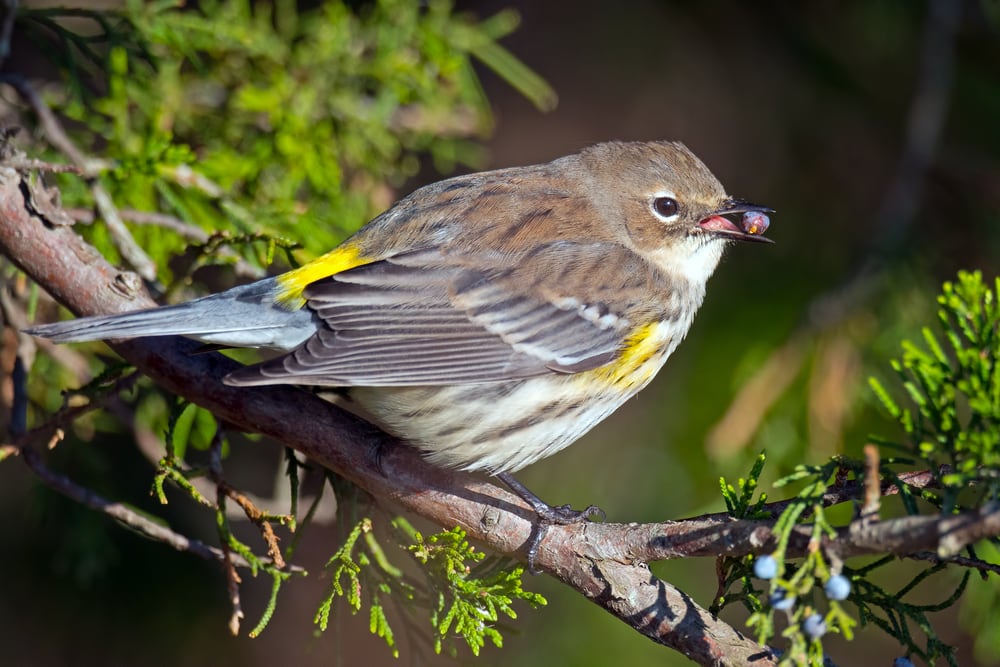
Showcasing its iconic yellow rump patch while flying, Yellow-rumped Warbler is one of the best-known winter warblers in Florida and its habitat includes road-sides, wood edges, marshes, and residential shrubs. While most of these bird species migrate to tropical areas in the fall, some feed on berries to stay in the north.
Yellow-rumped warblers can be classified into different forms, among those, the ‘Myrtle’ (east) and the ‘Audubon’ (west) are distinct and have noticeable features. Their diet includes berries and insects, during winters they feed on berries with wax coatings such as juniper berries, poison ivy, bayberry, etc.
The male yellow-rumped warblers have a brighter appearance than females and during courtship, the male accompanies females everywhere.
10. Common Grackle (Quiscalus quiscula)

This dazzling blackbird is a year-round resident of the sunshine state and closely resembles ‘the boat-tailed grackle’. Due to its abundance, Common Grackle can be further classified into three subspecies geographically that can be distinguished by colour.
From the north to west of the Appalachian Mountains, Common Grackle can be seen in dazzling bronze, in the southeast they can be seen in purple and the rest in green. In southern Florida, they can be seen with a mixture of purple and green iridescence.
These birds nest in colonies. Common Grackles are omnivorous and often feed on frogs, lizards, small rodents, and younglings of other birds. The male is more iridescent than the female.
11. Tufted titmice (Baeolophus bicolor)
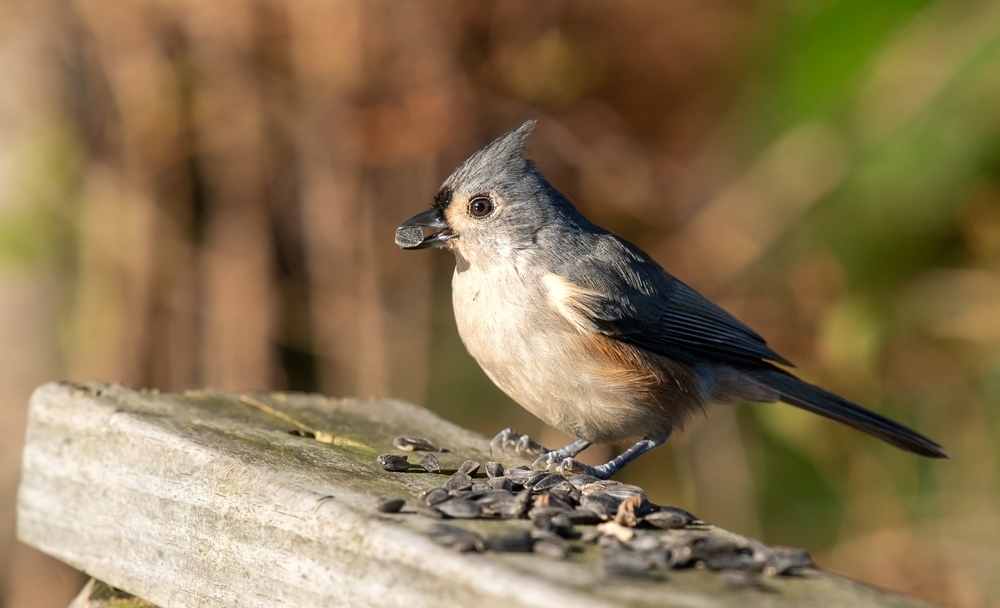
Abundant in the eastern deciduous forest these little grey crested birds are among the common backyard songbirds. In central Florida, they are permanent residents and can be seen residing in woodlands, orange groves, and backyards. One of their signature songs includes the whistled version of “peter-peter-peter”.
The females build the nests typically with a foundation of leaves, grass, bark strips, and other soft substances. They can be often seeing plucking hair from animals and humans to build nests. Tufted titmice feed on insects, seeds, nuts, berries, and other fruits.
These adorable looking birds are regular visitors at the feeders and sunflower seeds, peanuts berries attract them to the backyard. Sexual dimorphism does not exist in these species.
12. Ruby-throated hummingbird (Archilochus colubris)

Another highly recognizable hummingbird of Florida, the Ruby-throated hummingbird is found all around the year in woodlands, parks, meadows, edges of forests, grasslands, and backyards in the northwest and is considered to be non-migratory. This tiny bird shines like jewelry under the sun and has amazing flying speed, agility, and tremendous hovering capabilities.
The male has a bright green crown and an opalescent red throat whereas the female has a brown crown and sides. They are prominent for their controlled flight where the sounds of their beating wings can be heard and hence put up a great courtship display where the male flies in the shape of a pendulum back and forth the female.
They feed on insects and nectar and aggressively defend their feeders and flowers.
13. Bachman’s sparrow (Peucaea aestivalis)

Simple in appearance with melodious vocals, Bachman’s sparrow is more abundant in Florida than any other southeastern state of the United States of America where it is endemic. These species can be found in open oak or pine woods and the numbers are on the decline due to loss of habitat.
The Bachman’s sparrows are on the larger side of sparrows. They are considered to be secretive and shy and often hide in dense covers when not singing. They forage on the ground moving slowly in search of food, their diet includes insects and spiders in summers and feeds on seeds during winters.
The song of Bachman’s sparrow is a whistle and a trill.
14. Carolina chickadee (Poecile carolinensis)

This little bitty plump-bodied black-headed curious, acrobatic songbird is a native to the American southeast that can be found in mature forests and wooded sub-urban regions. Despite their size, Carolina chickadees are valiant, they try to drive off their predators such as owls, hawks, and snakes.
Most of these birds may mate for life and males are slightly larger. The female may build the nest with bark strips, grass, animal hair, and other plant material. Their diet includes berries, insects, and seeds. Carolina chickadee often visits backyards feeders for black oil sunflower seeds and hop among twigs while foraging.
This non-migratory bird shares a close resemblance with its relative ‘Black-capped chickadee’.
15. Great Egret (Ardea alba)

The largest of the scrabbling white birds in Florida, the Great Egret can be seen along wetlands and watersides. This bird is second in size to Great Blue Heron and is often mistaken for Great White Heron due to its close resemblance.
Great Egret wade both fresh and salty shallow water with its long curved neck and dagger-like yellowish-orange bill for fish. While foraging it stands still in the waters on its webbed feet for an unsuspected prey to pass by and uses its long neck and bill to strike with an astonishing speed.
During the breeding season, long plumes grow from its back (aigrettes). They rely on fish and other aquatic animals for food. The Great Egret is a symbol of one of the oldest environmental organizations in North America which is the ‘National Audubon Society’.
16. Great blue heron (Ardea herodias)

Often referred to as a crane and being the largest of herons in North America, the Great blue heron is highly adaptable and thrives in any waterbody. It lives, breeds, and nests in South Florida all around the year and is very elegant to look at during the flight or while preying. In coastal southern Florida, stark white subspecies can be found.
The long legs, tight S-shaped neck, undeniable sharp bill, and enormous wingspan ranging from 65.8 – 79.1 inches (1.67 – 2 meters) make the Great blue heron a skillful predator and it feeds on fish, rodents, frogs, reptiles, and other small birds. These birds’ foraging abilities are similar to Great Egret.
They often nest in colonies called “heronries”.
17. Wood Stork (Mycteria Americana)

Native stork of North America, The Wood Stork is a large wading bald bird with a thick bill and a body in a shape of a football. They can be spotted in wetlands and estuaries along the coast in Florida and their population throughout the continent is on a decline due to poor water management.
Similar to other wading birds, this specie forages in shallow waters with heads immersed and bills partly open, which is immediately shut once in contact with the prey. Their diet includes a wide variety of fish, insects, baby alligators, turtles, rodents, frogs, seeds, and other plant substances.
The younglings are considered noisy but the adults are silent except for hissing.
18. Fulvous Whistling-Duck (Dendrocygna bicolor)

An unusually proportional shallow wetlands bird, Fulvous Whistling-Duck is abundant in Africa, Asia, and America because of its amazing capability to travel long distances in flocks. In the sunshine state, this year-round duck can be found in rice fields, irrigated lands, ponds, lakes, marshes, slow-moving rivers but during winters they migrate to freshwater wetlands and marshes.
This multicoloured duck with a long neck and legs forage in water submerging the front part of the body to look for food underneath. It feeds on seeds and insects, depends heavily on plant material. The male has black on the neck whereas the female has more black on the crown.
Sometimes Fulvous Whistling-Duck acts more like a swan than a duck.
19. Ruby-crowned kinglet (Regulus calendula)

These small passerine songbirds belonging to the kinglet clan are widespread in North America and are smaller than chickadee or warblers. These can be found on any conifers during the summer and between the shrubs and bushes in winter. They are also common in backyards when there is a good source of food available.
The male has a distinguishing ruby coloured crown which is usually confined but can be seen during spring and summer when it is excited. These birds can be seen foraging in multiple levels of a tree and often hunt by hovering. Their diet mostly includes insects, ranging from flies, beetles to caterpillars and many more.
Interestingly these tiny birds metabolically use only 10-kilo (22 pounds) calories per day.
20. White Pelican (Pelecanus erythrorhynchos)

With a humungous wingspan of 96.1-114.2 inches (2.4 to 2.9 meters), long neck, and large bill, the White pelican is among other several snowbirds that can be found in America. It is very royal to look at during the flight and can be observed on lakes, wetlands, and coastal areas. Some male pelicans have a small horn on the bill indicating their strength.
American White Pelicans feed on the surface of the water, immersing their beaks to catch fish and other aquatic species giving them an appearance of a large duck during the process. Unlike Brown Pelicans, these do not plunge-dive. They travel in flocks for long distances.
Unlike showcased in the cartoons, American White Pelicans do not carry food in the pouches of their bill.
21. Red-Headed Woodpeckers (Melanerpes erythrocephalus)

The beautiful red-headed is intrinsically patterned like a checkerboard and is known for its very active demeanor and harsh calls. Its habitat includes orchards, groves, shade trees in town, and huge scattered trees. These bird species are endangered due to the decline of habitat and food supply.
Unlike other woodpeckers, these birds have more foraging techniques and fly out from the branch to catch their prey in the air or on the ground. Their diet includes a wide variety of seeds, berries, and insects and seldom feeds on small rodents and barks. Red-Headed Woodpeckers hide insects and seeds under bark, fencepost, and cracks in woods.
Some of the famous nicknames of this bird include shirt-tail bird, half-a-shirt, jellycoat, flag bird, and the well-known the flying checker-board.
22. Eastern bluebird (Sialia sialis)

A year-round breeder and resident of Florida, Eastern bluebird is known for its elegant blue feathers and belongs to the clan of thrush. It can often be sited in a hunched position on fences, wires, open woodlands, meadows, and fields and has adapted to use nest boxes. It is known to migrate to other areas during winter
The female of this species is known to have traces of grey above its blue wings and a lighter version of orange-brown on the breast. Eastern bluebird forages low on the grounds, hovering over to pick insects after inspection, and is also known to catch insects in the air. Its diet includes a wide variety of insects and berries and can be rarely seen feeding on snails, lizards, and tree frogs.
23. Whooping crane (Grus americana)
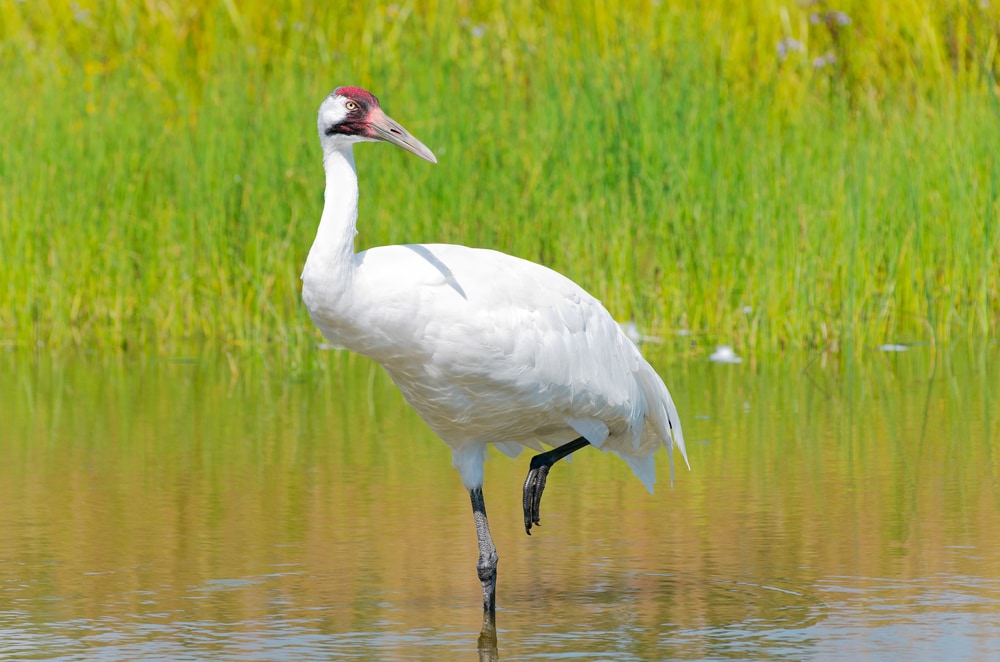
Once naturally occurring in the eastern United States until the mid-twentieth century, no evidence of the existence of the Whooping crane in Florida can be found until the 1930s, captive breeding and wetland management steadily increased the population of this endangered tall bird and now can be seen in the marshes, muskeg and prairie marshes of Florida.
Known for their crimson cap, yellow eyes, and thin black legs these bird species hunt for food in stealth mode, waiting patiently to catch their prey. They rely on various plant and animal diet which includes fish, aquatic animals, frogs, acorns, seeds, and berries.
Whooping cranes are agile in their courtship dance that involves wing-sweeping, head-pumping, leaping, and, kicking.
24. Anhinga (Anhinga anhinga)
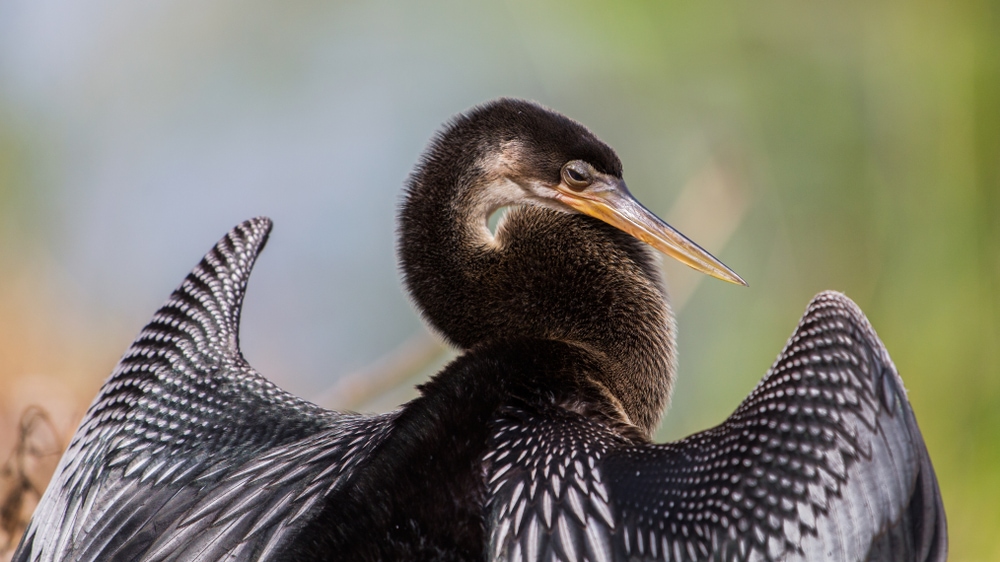
These dark water birds with a thin long neck, bill, and tail are classy fliers that travel long distances. Anhingas are year-round residents of Florida and are also known as snake birds and water turkeys and can be found in the coastal regions of the sunshine state. The male has white streaks on the back and wings whereas the female has a tan head, breast, and neck.
These bird species prey on fish either on the surface or underwater and are not classified as fast swimmers hence they wait for the fish to come closer and attack using the pointed bill. Their diet mostly consists of fish and sometimes feeds on turtles, baby alligators, and snakes.
Anhingas feathers are less water-resistant which aids in swimming underwater.
25. Laughing Gull (Leucophaeus atricilla)

Circling over beaches with noisy calls, these black-headed birds with red bills are among several other gulls that can be found in Florida, however, the Laughing gulls are summer visitors in the northeast and a year-round sight in the Gulf of Mexico and coasts of the southeast.
They can be found in the salt marshes, beaches, coastal bays, piers, and ocean and forage while swimming, walking, plunging into the water, or wading. Their diet includes insects, fish, and crustaceans. Laughing Gulls are known to be active during the day and both sexes work to build their nests together.
26. Bald eagle (Haliaeetus leucocephalus)
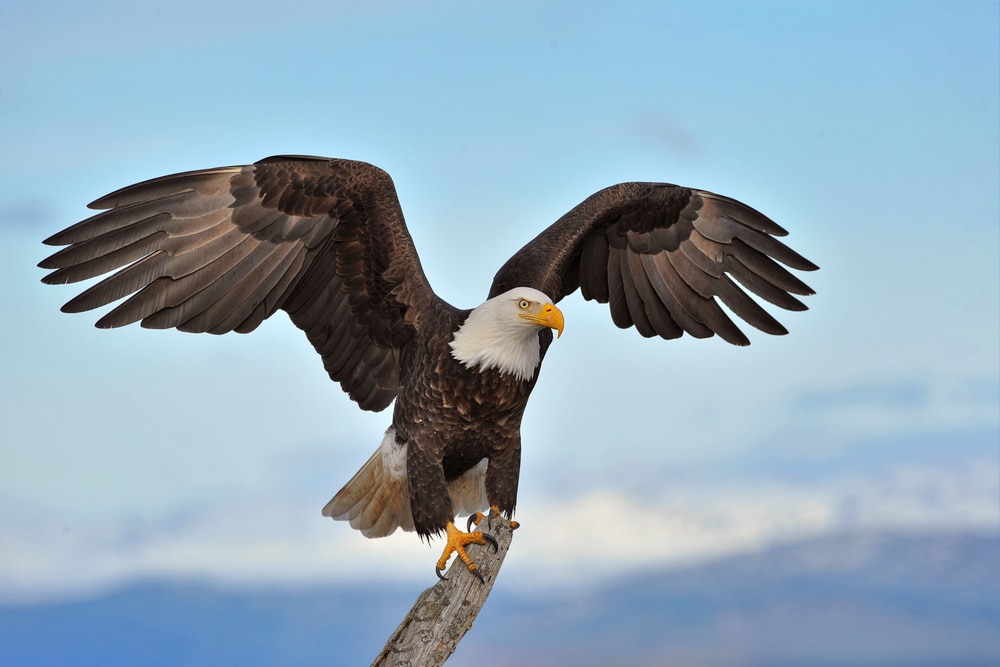
The American emblem bird is more than regal in its appearance and Florida is one of the states to have the densest population of nesting Bald eagle. This bird species is a strong predator often known for feeding on other small birds. Despite its appearance, the Bald eagle is not very royal in its behavior, it is known to steal food from Ospreys and feed on animal carnage.
These birds are very opportunistic and hunt mostly by watching with their sharp vision from a high perch and cruising down to catch the prey using their talons. Their diet includes fish, mammals, and fellow birds.
The Bald eagle has been removed from the endangered species list to the protected list.
27. Snail Kite (Rostrhamus sociabilis)

These grey-black raptors with curved rugged bills hunt for large freshwater snails and can be seen gliding over tropical wetlands. They are found in South and Central America but in the United States of America, they are only found in Florida and are thus on the federal endangered list.
These bird species are very eye-catching when they are hunting for snails in the morning. They hunt by gliding steadily over water surfaces or plants and pick up snails using one foot and use their bill to extract meat from the shell.
The Snail Kite was not discovered until 1817 in Rio de la Plata, Argentina.
28. Mangrove Cuckoo (Coccyzus minor)

This furtive, slender, and lanky-looking bird requires patience to find inside the dense vegetation and seldom sit in the open. Mangrove Cuckoo, true to its name can be seen in the mangrove swamps and tropical woodlots of Florida. They can also be found in the Caribbean and South American regions.
These birds perch in the canopies and can only be spotted by their distinct calls. They forage rather slowly between the branches of mangroves, observing and calculating its moves to prey on insects in foliage. They feed on a wide variety of insects and can rarely be seen feeding on berries and fruits.
29. Burrowing Owl (Athene cunicularia)

The Burrowing Owl is a bird that lives in treeless areas and is one of the smallest owls found in Florida. They can be found in farmlands, airfields, grassland, prairies and prefer living in an open grounded area where they dig up burrows by themselves or take over from the squirrels, tortoises, or prairie dogs to reside in.
These birds are nocturnal but hunt mostly during the day. They employ various methods such as flying, hovering, running over the fields and catching their prey using the talons. The Burrowing Owl’s diet includes insects, small mammals, and birds.
Unlike other birds, both sexes of this species are of the same size and the general population is on the decline due to loss of habitat due to human intervention.
30. Black-necked swans (Cygnus melancoryphus)
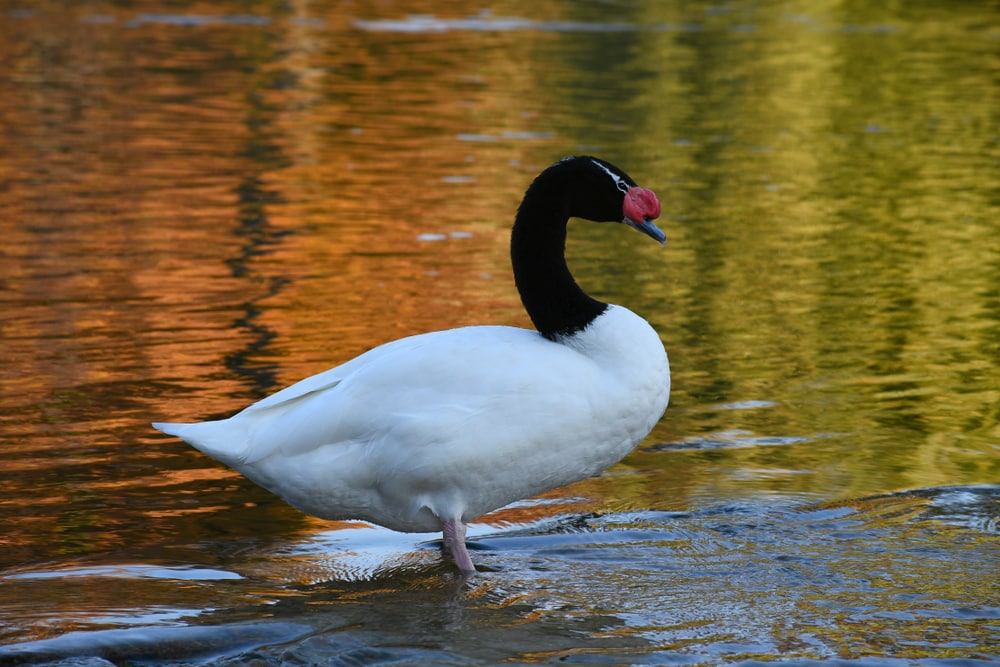
Native to South America, this magnificent bird is unmistakable and has a velvety black head with a scarlet knob known as the ‘caruncle’, a feature only present for an adult. This bird species is among the rarest and most vulnerable swans residing in Orlando’s Lake Eola Park and can be found in freshwater marshes, swamps, shallow lakes, and brackish lagoons.
These birds enjoy spending most of their time in water and sometimes face challenges walking but are strong flyers once they start flying. They rely mostly on a vegetarian diet both aquatic and land plants such as pondweeds and stonewort.
Black-necked swans are social and amicable but during the breeding season, they become aggressive and territorial.
You May also like:
Discover different species found in Florida here:

Wild Monkeys In Florida | Poisonous Frogs In Florida | Anoles In Florida | Alligators In Texas | Sharks in Florida | Largest Alligator In Florida | Beach Birds Of Florida | Snakes In Florida | Florida Turtles | Owls In Florida | Lizards In Florida | Florida Spiders | Geckos In Florida | Scorpions In Florida | Florida Frogs | Florida Freshwater Fish | Hawks In Florida | Woodpeckers In Florida | Vultures In Florida | Hummingbirds In Florida |








